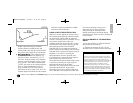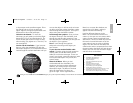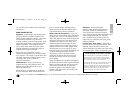
fun, and the more rewarding your telescope
will become.
SOME OBSERVING TIPS
Eyepieces: Always begin your observations
using the 25mm low-power eyepiece. The
25mm eyepiece delivers a bright, wide field
of view and is the best to use for most
viewing conditions. Use the high-power 9mm
eyepiece to view details when observing the
Moon and planets. If the image become
fuzzy, switch back down to a lower power.
Changing eyepieces changes the power or
magnification of your telescope.
By the way, you might have noticed
something strange when you looked through
your eyepiece. The image is upside down and
reversed. That means reading words can be
a problem. But it has no affect on
astronomical objects.
2X Barlow lens: You can also change
magnification by using a Barlow lens. The
Barlow lens doubles the power of your
telescope (See Fig. 9).
Meade offers a complete line of eyepieces
for your telescope. Most astronomers have
four or five low-power and high power
eyepieces to view different objects and to
cope with different viewing conditions.
Objects move in the eyepiece: If you are
observing an astronomical object (the Moon,
a planet, star, etc.) you will notice that the
object will begin to move slowly through the
telescopic field of view. This movement is
caused by the rotation of the Earth and
makes an object move through the tele-
scope’s field of view. To keep astronomical
objects centered in the field, simply move
the telescope on one or both of its axes—
vertically and/or horizontally as needed—try
using the telescopes coarse and fine
adjustment controls. At higher powers,
astronomical objects will seem to move
through the field of view of the eyepiece
more rapidly.
Place the object to be viewed at the edge of
the field and, without touching the telescope,
watch it drift through the field to the other
side before repositioning the telescope
so that the object to be viewed is again
placed at the edge of the field, ready to be
further observed.
JOIN AN ASTRONOMY CLUB, ATTEND A STAR PARTY
One of the best ways to increase your knowledge of
astronomy is to join an astronomy club. Check your
local newspaper, school, library, or telescope dealer/
store to find out if there’s a club in your area.
Many groups also hold regularly scheduled Star Parties
at which you can check out and observe with many
different telescopes and other pieces of astronomical
equipment. Magazines such as
Sky and Telescope
and
Astronomy
print schedules for many popular Star
Parties around the United States and Canada.
Vibrations: Avoid touching the
eyepiece while observing through the
telescope. Vibrations resulting from
such contact will cause the image to
move. Avoid observing sites where vibrations
cause image movement (for example,
near railroad tracks). Viewing from the
upper floors of a building may also cause
image movement.
Let your eyes “dark-adapt:” Allow five or
ten minutes for your eyes to become “dark
adapted” before observing. Use a red-
filtered flashlight to protect your night vision
when reading star maps, or inspecting the
13
Looking at or near the Sun will cause irreversible damage to your eye. Do not point this telescope at or near the Sun. Do not look through the telescope as it is moving.
Meade114EQASTR 3/28/07 9:33 AM Page 15


















